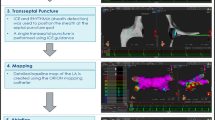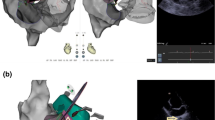Abstract
Background
Ablation procedures for arrhythmias have increased in frequency and complexity over the last decade. Improvements in technology have allowed for less reliance on fluoroscopy to guide these procedures. Ablation without fluoroscopy has been reported in small cohorts. We report a single center experience of fluoroless ablation after adoption of this technique for all endovascular ablations.
Methods
This retrospective study evaluated 107 consecutive patients who underwent a catheter ablation procedure for an atrial or ventricular arrhythmias after adoption of a completely fluoroless technique. No fluoroscopy was used in any case. A mapping system was utilized in all cases. Intracardiac echocardiography (ICE) catheters were utilized in 75 of the ablation cases (70.4 %). Of the 107 patients who underwent EP study, three patients did not undergo ablation as they were non-inducible for SVT. Of the remaining 104 patients, 56 patients (53.8 %) underwent ablation for atrial fibrillation, 23 patients (22.1 %) for SVT, 10 patients (9.6 %) for lone atrial flutter, and 16 patients (15.4 %) for a ventricular arrhythmia including PVC, idiopathic VT or ventricular tachycardia.
Results
Catheters were able to be placed in 100 % of patients without complication. Time to placement in the coronary sinus was 2.1 min ± 1.4 min. Mean transseptal time was 3.54 min ± 3 min. Mean procedure time for all ablations was 2 h 6 min ± 50 min. There were no complications in the series of patients.
Conclusions
Fluoroless ablation is feasible and safe with acceptable procedure times. Adoption of this technique is encouraged in order to eliminate unnecessary risk of fluoroscopy.






Similar content being viewed by others
References
Kneeland, P., & Fang, M. (2009). Trends in catheter ablation for atrial fibrillation in the United States. Journal of Hospital Medicine, 4(7), E1–E5.
Title 10, Section 20.1003, of the Code of Federal Regulations(10 CFR 20.1003).
Klein, L. W., Miller, D. L., Balter, S., et al. (2009). Occupational hazards in the interventional laboratory: time for a safer environment. Radiology, 250, 538–544.
Limacher, M. C., Douglas, P. S., Germano, G., Laskey, W. K., Lindsay, B. D., McKetty, M. H., Moore, M. E., Park, J. K., Prigent, F. M., & Walsh, M. N. (1998). ACCexpert consensus document: radiation safety in the practice of cardiology: American College of Cardiology. Journal of the American College of Cardiology, 31, 892–913.
Damilakis, J., Theocharopoulos, N., Perisinakis, K., Manios, E., Dimitriou, P., Vardas, P., & Gourtsoyiannis, N. (2001). Conceptus radiation dose and risk from cardiac catheter ablation. Circulation, 104, 893–897.
Kovoor, P., Ricciardello, M., Collins, L., Uther, J., & Ross, D. (1998). Risk to patients from radiation associated with radiofrequency ablation for supraventricular tachycardia. Circulation, 98, 1534–1540.
Roguin A. Radiation hazards to interventional cardiologists: A report on increased brain tumors among physicians working in the cath lab. SOLACI 2014; April 23, 2014; Buenos Aires, Argentina.
Lickfett, L., Mahesh, M., Vasamreddy, C., Bradley, D., Jayam, V., Eldadah, Z., Dickfeld, T., Kearney, D., Dalal, D., Luderitz, B., Berger, R., & Calkins, H. (2004). Radiation exposure during catheter ablation of atrial fibrillation. Circulation, 110, 3003–3010.
Drago, F., Silvetti, M. S., Di Pino, A., Grutter, G., Belivacqua, M., & Leibovich, S. (2002). Exclusion of fluoroscopy during ablation treatment of right sided accessory pathways in children. Journal of Cardiovascular Electrophysiology, 13, 778–782.
Grubb, N., Petzer, E., Lang, C., Colthart, A., & Elhag, O. (2006). A zero fluoroscopy approach for electrophysiologic studies and catheter ablation for common supraventricular tachycardias. Heart Rhythm, 3, S123.
Ebrille, E., Caponi, D., Siboldi, A., Di Donna, P., Di Clemente, F., Gabbarini, F., Bertero, G., Marasini, M., Gaita, F., & Scaglione, M. (2013). Single center experience of fluoroless AVNRT ablation guided by electroanatomic reconstruction in children and adolescents. Pacing and Clinical Electrophysiology, 36(12), 1460–1467.
Ferguson, J. D., Helms, A., Mangrum, J. M., Mahapatra, S., Mason, P., Bilchick, K., McDaniel, G., Wiggins, D., & DiMarco, J. P. (2009). Catheter ablation of atrial fibrillation without fluoroscopy using intracardiac echocardiography and electroanatomic mapping. Circulation. Arrhythmia and Electrophysiology, 2, 611–619.
Reddy, V. Y., Morales, G., Ahmed, H., Neuzil, P., Dukkipati, S., Kim, S., Clemens, J., & D’Avila, A. (2010). Catheter ablation of atrial fibrillation without the use of fluoroscopy. Heart Rhythm, 7, 1644–1653.
Faletra, F., Regoli, F., Nucifora, G., & Auriccio. (2011). Real-time, fluoroless, anatomic-guided catheter navigation by 3D TEE during ablation procedures. Journal of the American College of Cardiology: Cardiovascular Imaging, 4(2), 203–206.
Finkelstein, M. M. (1998). Is brain cancer an occupational disease of cardiologists? The Canadian Journal of Cardiology, 14, 1385–1388.
Vaño’, E., González, L., Beneytez, F., & Moreno, F. (1998). Lens injuries induced by occupational exposure in non-optimized interventional radiology laboratories. The British Journal of Radiology, 71, 728–733.
Moore, B., van Sonnenberg, E., Casola, G., & Novelline, R. A. (1992). The relationship between back pain and lead apron use in radiologists. AJR. American Journal of Roentgenology, 158, 191–193.
Ector, J., Dragusin, O., Adriaenssens, B., Huybrechts, W., Willems, R., Ector, H., & Heidbüchel, H. (2007). Obesity Is a major determinant of radiation dose in patients undergoing pulmonary vein isolation for atrial fibrillation. Journal of the American College of Cardiology, 50(3), 234–242.
Klein, L. W., Miller, D. L., Balter, S., Laskey, W., Haines, D., Norbash, A., Mauro, M. A., & Goldstein, J. A. (2009). Occupational health hazards in the interventional laboratory: time for a safer environment. Radiology, 250, 538–544.
Clark, J., Bockoven, J. R., Lane, J., Patel, C. R., & Smith, G. (2008). Use of three-dimensional catheter guidance and trans-esophageal echocardiography to eliminate fluoroscopy in catheter ablation of left-sided accessory pathways. Pacing and Clinical Electrophysiology, 31, 283–289.
Smith, G., & Clark, J. M. (2007). Elimination of fluoroscopy use in a pediatric electrophysiology laboratory utilizing three-dimensional mapping. Pacing and Clinical Electrophysiology, 30, 510–518.
Razminia, M., Manankil, M. F., Eryazici, P. L., Arrieta-Garcia, C., Wang, T., D’Silva, O. J., Lopez, C. S., Crystal, G. J., Khan, S., Stancu, M. M., Turner, M., Anthony, J., Zheutlin, T. A., & Kehoe, R. F. (2012). Nonfluoroscopic catheter ablation of cardiac arrhythmias in adults: feasibility, safety, and efficacy. Journal of Cardiovascular Electrophysiology, 23(10), 1078–1086.
Author information
Authors and Affiliations
Corresponding author
Ethics declarations
Conflict of interest
The authors declare that they have no competing interests.
Rights and permissions
About this article
Cite this article
Sánchez, J.M., Yanics, M.A., Wilson, P. et al. Fluoroless catheter ablation in adults: a single center experience. J Interv Card Electrophysiol 45, 199–207 (2016). https://doi.org/10.1007/s10840-015-0088-z
Received:
Accepted:
Published:
Issue Date:
DOI: https://doi.org/10.1007/s10840-015-0088-z




